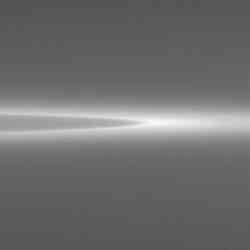
Saturn’s G ring. Image credit: NASA/JPL/SSI Click to enlarge
This Cassini photograph shows Saturn’s faint G ring, with its sharp inner edge and more diffuse outer boundary. When Cassini arrived at Saturn nearly two years ago, it flew directly through this ring, using its main antenna as a shield; a wise move as it was struck several times by icy particles. This image was taken on January 19, 2006 when Cassini was 1.2 million km (700,000 miles) from Saturn.
This contrast-enhanced view of Saturn’s faint G ring shows its extremely sharp inner edge and more diffuse outer boundary. Using its large high-gain antenna as a shield, the Cassini spacecraft flew through the region interior to the G ring during insertion into Saturn orbit. The spacecraft was struck many times by the fine icy particles that populate the region between the F and G rings.
The image was taken in visible light with the Cassini spacecraft narrow-angle camera on Jan. 19, 2006, at a distance of approximately 1.2 million kilometers (700,000 miles) from Saturn. The image scale is 7 kilometers (4 miles) per pixel.
The Cassini-Huygens mission is a cooperative project of NASA, the European Space Agency and the Italian Space Agency. The Jet Propulsion Laboratory, a division of the California Institute of Technology in Pasadena, manages the mission for NASA’s Science Mission Directorate, Washington, D.C. The Cassini orbiter and its two onboard cameras were designed, developed and assembled at JPL. The imaging operations center is based at the Space Science Institute in Boulder, Colo.
For more information about the Cassini-Huygens mission visit http://saturn.jpl.nasa.gov . The Cassini imaging team homepage is at http://ciclops.org .
Original Source: NASA/JPL/SSI News Release
